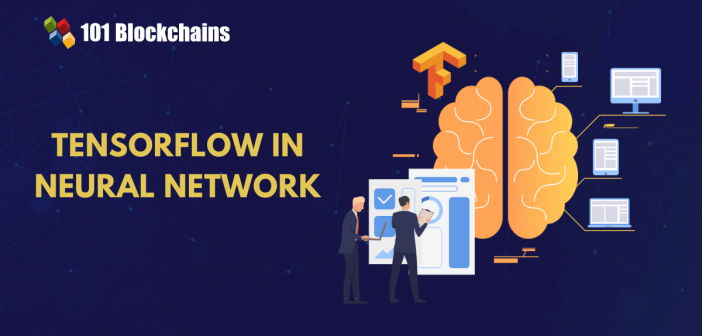Learn how blockchain truly works, master key definitions, and uncover what makes smart contracts so "smart." Dive into the fundamentals, gain valuable insights, and start your blockchain journey today!

- AI & ChatGPT
James Howell
- on June 14, 2024
What is TensorFlow in Neural Network?
Machine learning has been one of the most complex disciplines in the domain of technology. Interestingly, it is easier to deploy machine learning models with tools like TensorFlow by Google. The tech giant released the open-source framework in November 2015 and revolutionized the AI landscape. The use of TensorFlow in neural network training, general numerical calculations, and deep learning on CPUs and GPUs has elevated the standards of AI systems.
TensorFlow hosts an open-source community that includes developers, data engineers, and data scientists who contribute to the TensorFlow repository. As of now, it is the most popular AI framework, and it has promising potential for neural network training. Let us learn more about the fundamentals of TensorFlow, its working mechanism, and use cases, as well as discover how you can use it in neural networks.
What are the Capabilities of TensorFlow?
The best approach to understanding how TensorFlow neural network code is better than with other frameworks is to learn its definition. It is an open-source library tailored for large-scale machine learning, numerical computation, and deep learning. TensorFlow also supports other predictive analytics and statistical workloads. With TensorFlow, the process of data collection, drawing predictions at scale, and optimizing future outcomes becomes easier. As a result, developers can make the most of TensorFlow for faster and easier implementation of machine learning models.
The capabilities of TensorFlow help in training and running deep learning networks for different tasks such as image recognition, NLP, handwritten digit classification, and word embeddings. You can add the code in its software libraries to any application and help it in learning the tasks. Any TensorFlow neural network example would operate on conventional CPUs or high-performance GPUs. On top of that, TensorFlow also leverages the tensor processing units or TPUs, which are tailored specifically for accelerating TensorFlow jobs.
Working Mechanism of TensorFlow
The ability of TensorFlow to handle neural network workloads depends on their working mechanism. You can find three distinct elements in the TensorFlow workflow such as,
- Preprocessing data.
- Model development.
- Training of the model to draw predictions.
You can find the answers to “Why TensorFlow is used in CNN?” with a detailed explanation of its unique architecture. The framework takes in data in the form of a multidimensional array or tensors and then follows an execution process in two different ways. The first method involves development of a computational graph to define the data flow for training a model.
On the other hand, you can choose a more intuitive method with eager execution that relies on imperative programming principles. The eager execution approach also ensures faster assessment of operations. The TensorFlow architecture helps implement the training process on a desktop or a data center according to your needs. It is important to note that using tensors on the GPU can help accelerate the training process.
Another important aspect of the working mechanism of TensorFlow refers to the broad range of supporting features. For example, the TensorFlow neural network playground allows you to tinker with a neural network without any obligations. You can also access the TensorBoard to visually monitor the training process and the underlying computational graphs and evaluate model performance. You can also rely on Keras, the high-level API running on top of TensorFlow, to build models for general use cases. It can help you translate your ideas for a neural network into results faster than possible.
Want to understand the importance of ethics in AI, ethical frameworks, principles, and challenges? Enroll now in Ethics Of Artificial Intelligence (AI) Course!
What are the Popular Examples of TensorFlow Business Use Cases?
You might wonder why you should focus on TensorFlow for neural network training when you can choose other alternatives. The applications of TensorFlow in neural network training have more credibility due to the proven and tested business use cases of the framework. For example, Airbus uses TensorFlow to extract and analyze information sourced from satellite images to obtain valuable real-time insights for clients.
PayPal has leveraged TensorFlow for generative modeling and deep transfer learning to enable faster recognition of complex fraud patterns with temporary variations. Social media giant Twitter has also utilized TensorFlow to create the Ranked Timeline, which ensures that users catch up with important tweets while following other users.
Identify new ways to leverage the full potential of generative AI in business use cases and become an expert in generative AI technologies with Generative AI Skill Path
What is the Neural Network Playground?
Speaking of the advantages associated with TensorFlow, it is important to reflect on the significance of their neural network playground. The TensorFlow neural network playground is an ideal platform for making neural networks more accessible to users and for easier learning capabilities. Anyone can use the neural network playground in any way while ensuring compliance with the Apache License. You can find different types of controls that help you customize the playground for a specific lesson or topic.
One of the most notable aspects of the neural network playground is the use of colors in the visualization. For example, you can find orange and blue in the visualizations in different ways. The general assumption about orange is that it indicates negative values, and blue indicates positive values. You can find data points in the form of small circles that are initially colored in orange or blue.
You would also note that the hidden layers have lines colored according to weights of connections between the neurons. Blue represents positive weight and suggests that the network uses the output of the neuron as specified. On the other hand, orange lines suggest that the network has assigned a negative weight.
The output layer has different dots that are orange or blue, according to the original values. The background color in the playground visualization shows the prediction of the network for a specific area. On top of it, the intensity of color describes the confidence in the prediction.
How Does TensorFlow Perform Better for Neural Networks?
TensorFlow has been touted as an effective machine learning framework since its introduction. However, it is time to reflect on queries like “Why TensorFlow is used in CNN?” to understand how TensorFlow supports neural networks. You can find the best answers for such queries in the new learning paradigm on TensorFlow for training neural networks. Neural Structured Learning, or NSL, is the new paradigm for training neural networks with the help of structured signals alongside feature inputs. The structure can be implicit, such as the one created due to adversarial perturbation, or explicitly represented in a graph.
Structured signals generally help represent relations or the similarity between labeled or unlabeled samples. Using such signals during the training process helps capitalize on labeled and unlabeled data, thereby improving model accuracy. It works best in scenarios where you have a relatively small amount of labeled data. On top of it, TensorFlow neural network example also suggests that models trained on samples generated through addition of adversarial perturbation can have better resilience against malicious attacks.
NSL can be generalized to adversarial learning and neural graph learning. The TensorFlow NSL framework offers different easy-to-use APIs and tools that help developers train models with structured signals. Some of the notable APIs and tools used for training neural network models include Keras APIs, TF ops, and functions and tools for building graphs and graph inputs for the training process.
Learn about the prerequisites and important steps to Install TensorFlow Keras.
Exploring the Significance of TensorFlow for Neural Networks
The importance of TensorFlow as a promising framework for neural network training revolves largely around Neural Structured Learning. It is an easy-to-use framework that helps beginners and expert developers in training neural networks by leveraging structured signals.
A detailed review of TensorFlow neural network code would also point out the fact that NSL can help build robust and accurate models for computer vision, prediction, and language understanding tasks. With the help of structured signals, developers can achieve more accuracy and robust design of models. In addition, they have helped Google improve model performance, especially in learning image semantic embedding.
Neural structured learning, or NSL, serves as an open-source framework that helps train deep neural networks by using structured signals. It utilizes neural graph learning that helps in training neural networks with graphs. Developers can obtain the graphs from different sources, such as multimodal relations, knowledge graphs, genomic data, and medical records.
On the other hand, the working of TensorFlow in neural network training also points to adversarial learning. The adversarial learning approach involves dynamic construction of the structure between input examples by leveraging adversarial perturbation.
Neural Structured Learning helps TensorFlow users easily incorporate different structured signals for training of neural networks. On top of that, neural structured learning is applicable to various learning scenarios, such as supervised, unsupervised, and semi-supervised learning settings.
Become a master of generative AI applications by developing expert-level skills in prompt engineering with Prompt Engineer Career Path
Final Words
The discussions about using TensorFlow for neural networks can be significantly challenging for anyone in the artificial intelligence landscape to interpret. It is obviously one of the top machine learning frameworks with different supporting features. However, the arrival of new features such as TensorFlow neural network playground and Neural Structured Learning have made the platform more capable of building and training neural networks.
TensorFlow is a popular framework adopted by big companies such as Airbus, PayPal, and Twitter for different business use cases. Therefore, it is reasonable to explore the potential of TensorFlow to create advanced neural networks for innovative applications. Learn more about neural networks and their different variants to understand the significance of frameworks like TensorFlow for the future.







